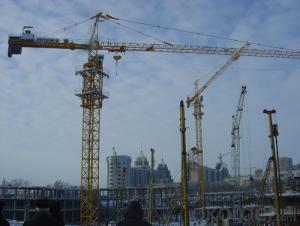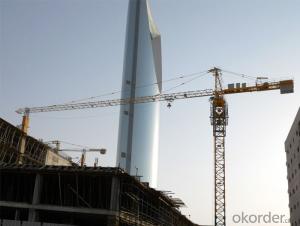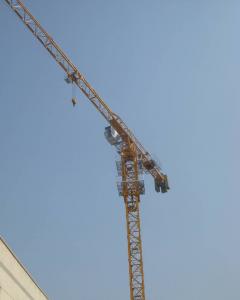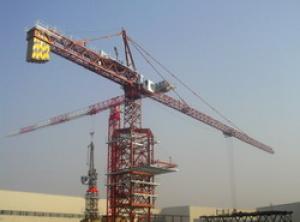QTZ50(5010A) tower crane
- Loading Port:
- Qingdao
- Payment Terms:
- TT OR LC
- Min Order Qty:
- 1 set
- Supply Capability:
- 12 set/month
OKorder Service Pledge
OKorder Financial Service
You Might Also Like
QTZ50(5010A) tower crane is hoisting and conveying machinery which is designed by fully utilizing the group technology, the combinational design technology and the finite element analysis technology and taking the tower crane microcomputer design platform as a tool and has excellent performance.
The crane is a horizontal-arm-rest trolley-amplitude upper-revolution hydraulic lifting type crane which has the effective amplitude of 50m and the maximum lifting moment of 500kN•m. The tower crane has the lifting height of 30m and the adhesion lifting height of 120m (2 magnification) during independent use.
All the speed indexes of the crane meet or surpass national standards.
The crane has the total installed capacity of 25.5kW, features advanced parameters, excellent and reliable properties, attractive appearance, high quality, simple and practical structures, advanced safety devices, convenient maintenance, safe usage and reasonable prices, and is ideal construction machinery for many medium-small construction enterprises.
The lifting boom and balance boom adopt cantilever boom structure, which reduces the hoisting modular and makes it more safe, convenient and flexible to install and uninstall, and reduces the requirements for hoisting equipment and the site.
2. Multiple special mounting brackets are available, which saves the installation time and ensures safe and quality installation.
3. The lifting boom adopts cantilever boom structure and variable cross-section materials, featuring more reasonable structural stress and long service life; and it is easier to make different combination of boom length.
Technical Performance Parameter Table
Item | Unit | Magnification | ||
α=2 | α=4 | |||
Rated lifting moment | kN.m | 500 | ||
Maximum lifting capacity | t | 2 | 4 | |
Working amplitude | m | 3 ~50 | ||
Maximum amplitude lifting capacity | t | 0.8 | ||
Lifting height | Independent | m | 30 | |
Attached | m | 120 | ||
Time of moving outrigger end to rotation center | m | 50.74 | ||
Time of moving balance arm tail to rotation center | m | 12.816 | ||
Counter weight | t | 8.54 | ||
Total motor power | kW | 25.5 | ||
Allowable working temperature | 0C | -20~+40 | ||
2.1 Hoisting and Lifting characteristic curve characteristics table
(1)4-magnification Lifting Performance Table
Amplitude(m) | 3-12.5 | 13 | 14 | 15 | 16 | 17 | 18 | 19 | 20 | 21 | 22 |
Lifting capacity | 4 | 3.832 | 3.534 | 3.276 | 3.050 | 2.850 | 2.673 | 2.514 | 2.371 | 2.242 | 2.124 |
Amplitude(m) | 23 | 24 | 25 | 26 | 27 | 28 | 29 | 30 | 31 | 32 | 33 |
Lifting capacity | 2.017 | 1.918 | 1.828 | 1.744 | 1.667 | 1.595 | 1.528 | 1.466 | 1.407 | 1.353 | 1.301 |
Amplitude(m) | 34 | 35 | 36 | 37 | 38 | 39 | 40 | 41 | 42 | 43 | 44 |
Lifting capacity | 1.253 | 1.207 | 1.164 | 1.124 | 1.085 | 1.048 | 1.013 | 0.98 | 0.949 | 0.918 | 0.89 |
Amplitude(m) | 45 | 46 | 47 | 48 | 49 | 50 | |||||
Lifting capacity | 0.862 | 0.836 | 0.811 | 0.787 | 0.764 | 0.742 |
(2)2-magnification Lifting Performance Table
Amplitude(m) | 3-23.9 | 24 | 25 | 26 | 27 | 28 | 29 | 30 | 31 | 32 | |
Lifting capacity | 2 | 1.99 | 1.90 | 1.81 | 1.74 | 1.66 | 1.60 | 1.53 | 1.47 | 1.42 | |
Amplitude(m) | 33 | 34 | 35 | 36 | 37 | 38 | 39 | 40 | 41 | 42 | |
Lifting capacity | 1.37 | 1.32 | 1.27 | 1.23 | 1.19 | 1.15 | 1.11 | 1.07 | 1.04 | 1.01 | |
Amplitude(m) | 43 | 44 | 45 | 46 | 47 | 48 | 49 | 50 | |||
Lifting capacity | 0.98 | 0.95 | 0.92 | 0.90 | 0.87 | 0.85 | 0.82 | 0.80 | |||
- Q: What is the calibration value of a tower crane?
- Do you mean the calibration value of crane lifting moment? That should be the product of the maximum magnitude of the tower crane and the corresponding maximum lifting load.
- Q: S930 M50 (M125/75) level jib tower crane about how much money
- Do you want to see is that, generally is Sishijiwan
- Q: what does dog everything mean in crane lift lingo?
- i think it means to stop.
- Q: can some one give me contact details for O & K Marine Crane Manufacturer?
- there okorder /
- Q: I need a answers to these questions for a school project.These questions are:-How and when did it occur when the Siberian White Crane got threatened and critically endangered?What are the causes of this environmental issue?What are the effects of this environmental issue?What has or is being done to prevent such and environmental issue occurring again?Thanks, it will really help me with my final mark.
- Check okorder . There is some very interesting information at this site.
- Q: electromagnetic crane
- Current sent through a coil of wire creates a magnetic field, which can be used to pick up ferromagnetic objects. Turn off the current, and the field will turn off (although it might take a few seconds to turn off all the way), dropping the object.
- Q: Why are crane flies called mosquito eaters?
- That name and others are colloquial usage. Crane fly larvae will incidentally eat mosquito larvae if it is available to them.
- Q: A site would be nice...
- I just used that poem for a project!
- Q: I am writing a story for school about working in Dubai as a crane driver but I need to know what the purpose of a Crane driver is, how much they get payed and stuff like that. And if you could tell me how a crane driver can get admission in the first place, it would be really great. Thanx. And btw, this story is for Geography.Thank you. :)
- i am not a crane driver myself , but into this field of construction . get a licence as driver from authority just as a car driver. know how to drive the crane ad a driver know how to operate a crane as a operator. know the performance of the crane and its limits. the salary can vary depending on the type of crane and its special features. but not in the high end grade for sure unless its a very specialised crane operation. u can ask any thing more .
- Q: If you make 1000 origami cranes is it true that you will get a wish or good luck. This is based on a Japanese myth
- It's like asking: If you make a wish on a shooting star, will it come true? Although both are nice gestures, no it will not come true. Origami cranes are simply pieces of paper that are folded to resemble birds; no matter how many you make, they will not take on supernatural abilities such as wish-granting.
Send your message to us
QTZ50(5010A) tower crane
- Loading Port:
- Qingdao
- Payment Terms:
- TT OR LC
- Min Order Qty:
- 1 set
- Supply Capability:
- 12 set/month
OKorder Service Pledge
OKorder Financial Service
Similar products
Hot products
Hot Searches
Related keywords
























